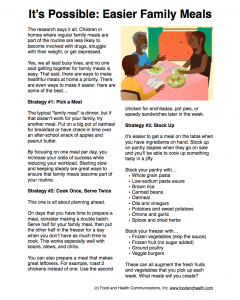The Benefits of Family Meals
Today we are deeper look at a topic and laying out a position based on research, data, and experience. And be sure to push through to the end, where great resources and a free handout are waiting. Are you ready for this?Topic: Family MealsPosition: The benefits of family meals outweigh the challenges.Over 31 billion dollars have been spent on the war on drugs, and that's just in 2014. According to DrugSense.org, this figure is double what was spent in 2010. What most people might not realize is that the family meal could be an important tool to help prevent future citizens of the United States from choosing a lifestyle that includes drugs. How so? Well, the CASAColumbia Foundation cites a study that shows that frequent family dinners cut teen’s substance abuse risk in half! Furthermore, having 3 or more family dinners per week means that teens are half as likely to smoke or get drunk. If you could avoid a lifetime of heartache by providing your family with more meals together, wouldn’t you want to run to the grocery store right now? Most people would say yes. However, a new study by Dr. Sarah Bowen from North Carolina State University concludes that the family meal ideal is too stressful for many families. Since there are many benefits to family meals, including their role in drug prevention, the author of this paper would like to uncover the ideals and stressors stated by Dr. Bowen and weigh their impact. Are these stressors and negative findings so bad that they negate the benefits? Let’s find out!First let’s explore the rest of the benefits of the family meal. These have all been featured in peer-reviewed journals.The North Dakota State University (NDSU) publishes "Eat Smart. Play Hard. Together." This newsletter offers a wonderful list of benefits of the family meal, both for children in particular and families as a whole. These include many brilliant ideas that most people would have taken for granted. The most important is parental monitoring. Dinner offers an opportunity to check in about friends, activities, and attitudes. A change in these might be a red flag to parents, who can then step in before problems get more serious. Moreover, family mealtime brings structure and routine to a child and adds a sense of stability to their lives. This regular mealtime also makes a positive impact on language and literacy development. Why? Because children are engaging in active conversation with adults. Furthermore, family connections and memories are built during meals together. They are and should be opportunities for family fun. The authors at NDSU bring up the important point that a family meal is a great replacement for TV and media distractions, which are shown to pose health and development risk factors. For example, TV ads emphasize fast food, sugary food, and high-calorie drinks. With the children's overweight and obesity rate at over 33% in our country, this is no laughing matter!Families influence children’s dietary choices and children develop food preferences at home that last well into adulthood. Families influence their children’s tastes and ability to control portions. Additionally, the availability of fruits and vegetables at home can have a lasting positive influence on nutrition and health for children. Increased frequency of family meals has even been shown to have a lower BMI in some studies.Let's look at some data. By choosing to eat more meals at home instead of away, study participants benefited from an improved dietary intake. Meals eaten away from home consistently contain more fat, sodium, and calories. They are often too large in size and contain a lot more calories, fat, and sodium than one would use at home. The USDA food icon, MyPlate, housed at www.choosemyplate.gov emphasizes the importance of eating more family meals at home.Consider these calorie comparisons:
- Lemon pepper fish from home 346 calories
- Lemon pepper fish from restaurant 773 calories
- Grilled chicken from home 434 calories
- Grilled chicken from restaurant 766 calories
Children who eat regular family meals at home are also 35% less likely to suffer from eating disorders. Eating disorders like bulimia and anorexia are devastating conditions and can even be life-threatening. Almost 30 million people in the U.S. suffer from them at some point in their life. By age 6, girls start to express concerns about their own weight or shape. 40-60% of elementary girls are concerned about becoming too fat and this will endure through their lives.The Family Dinner Project lists teen pregnancy, avoidance of depression, and higher grade point averages and self-esteem as research-proven benefits of regular family meals.With all of these benefits that help avoid the serious ills of adolescents and teenagers, why would parents hesitate to make regular family dinners part of their routine?Dr. Sarah Bowen, a researcher at North Carolina State University, interviewed 150 female caregivers who have children between the ages of 2 and 8. These interviews added up to 250 hours of data. Bowen found that middle class, working class, and poor families all faced similar challenges. Mothers of all backgrounds reported difficulty in finding time to prepare meals that everyone in the family would be willing to eat. Bowen's research paper link was posted as an item of concern to the Linkedin Group for the American Association of Family and Consumer Science.The middle-class caregivers felt a pull between the desire to spend time with their children and the need to cook the meal. They were also stressed because they could not afford to buy all organic foods. The family and consumer science professionals who posted comments to the Linkedin Group questioned the study. One comment stood out: “Who told the middle class moms they need to provide organic foods?” The Linkedin Group agreed that education about the benefits of family meals, along with tutorials about basic cooking skills would go a long way towards helping the middle-class caregivers.The poor caregivers faced the most severe restrictions. Their finances made it hard for them to go grocery shopping, buy food, and afford the tools to prepare the meals. The poor caregivers skipped meals and stood in long lines at food pantries to obtain food to feed their children. After exploring Bowen's findings, the family and consumer science educators stated that poor caregivers need to have more community help, education, and support.Bowen's study does not test whether or not the struggles to put dinner on the table are any different over time. It did nothing to try to educate the moms about the benefits of family meals to see if their attitudes would change. Furthermore, it does not look like family meals are being replaced by meals eaten away from home. While the dollars spent on meals eaten away from home are increasing, the USDA has reported a steady increase in the meals eaten at home since the Great Recession, and this number has stayed pretty steady since 1990.Perhaps Mary Story and Dianne Neumark-Sztainer, two popular researchers on family meals, made the best suggestions for families who struggle. They recommend that you make the family meal a priority at least four times a week. Dinner might be the easiest, but other times can count, too. The meals can be simple. And it is important for children to learn to cook and help with the meals so they can learn valuable skills that will help them throughout their lives. Regular meals are key components of family life that make a tremendous difference in the lives of children. These meals contribute to the reduction of risk of teen pregnancy, drugs, alcohol abuse, and failure in school. They are a great way for parents to connect with their children, monitor their activities and well-being, and promote literacy and healthful eating for parents too.By Judy Doherty, PC IIWorks Cited:"American Association of Family & Consumer Sciences (AAFCS)." World's Largest Professional Network. Linkedin, 21 Sept. 2014. Web. 21 Sept. 2014.Bowen. "'Family Meal' Ideal Is Stressful, Impossible for Many Families." NC State News Family Meal Ideal Is Stressful Impossible for Many Families Comments. September 18, 2014. Web. 21 Sept. 2014.Brotherson, Sean. "North Dakota State University." The Big Benefits of Family Meals from Eat Smart Play Hard Magazine. Agricultural Extension of North Dakota State University, January, 2009. Web. 21 Sept. 2014.CASAColumbia Foundation. “The Importance of Family Dinners II.” Sept. 2005. Web. Oct. 4, 2014.CASAColumbia Foundation. “The Importance of Family Dinners VII.” Sept. 2012. Web. Oct. 4, 2014.Center for Disease Control. “Childhood Obesity Facts.” August 13, 2014. Web September 28, 2014.Cook, Eliza, and Rachael Dunifon. "Do Family Meals Really Make a Difference?" Cornell University College of Human Ecology, 2012. Web. 21 Sept. 2014.Drug War Clock. “Money Spent on the War On Drugs This Year.” DrugSense.org. Oct. 4, 2014, Web. Oct. 4, 2014Fishel, Ann. "FAQ - The Family Dinner Project." The Family Dinner Project. The Family Dinner Project, 21 Sept. 2014. Web. 21 Sept. 2014.Get the Facts on Eating Disorders. National Eating Disorders. 2011. Web. September 30, 2014.Gruber KJ, Haldeman LA. Using the family to combat childhood and adult obesity. Prev Chron Disease. 2009; 6:A106.Larson NI, Neumark-Sztainer D, Jannan PJ, Story M. Family meals during adolescence are associated with higher diet quality and healthful meal patterns during young adulthood. J Am Diet Assoc. 2007; 107:1502–10.Neumark-Sztainer, D., Wall, M., Story, M., & Fulkerson, J. (2004). Are family meal patterns associated with disordered eating behaviors among adolsecents? Journal of Adolescent Health, 35, 350-359.Story, M., and Neumark-Sztainer, D. A perspective on family meals: Do they matter? Nutrition Today, 40 (6), 261-266; 2005.Taveras EM, Rifas-Shiman SL, Berkey CS, Rockett HR, Field AE, Frazier AL, et al. Family dinner and adolescent overweight. Obes Res. 2005; 13:900–6.Tumin R*, Anderson SE. The epidemiology of family meals among Ohio's adults. Public Health Nutrition 2014; In press.USDA. "Cook More Often at Home." Cook More Often at Home. USDA MyPlate, June 2011. Web. 21 Sept. 2014."USDA ERS - Food Expenditures." USDA ERS - Food Expenditures. USDA, 16 Sept. 2014. Web. 21 Sept. 2014.Want more resources to help your clients make family meals a reality? Check out these great materials...

 You can also offer your clients some great family meals strategies with this basic handout. It's free, so download it today!
You can also offer your clients some great family meals strategies with this basic handout. It's free, so download it today!


